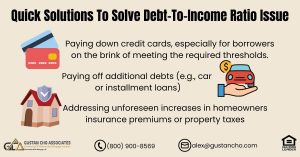This BLOG On Front End Debt To Income Ratios Mortgage Guidelines Was UPDATED On November 12th, 2018

There are two different types of debt to income ratios:
- Front End Debt To Income Ratios
- Back End Debt To Income Ratios
A homeowner’s monthly mortgage payment consists of the following and is called P.I.T.I.
- Principal
- Interest
- Property Taxes
- Homeowners Insurance
The above is called P.I.T.I. However, many borrowers have other expenses as part of their monthly housing expenses. Front End DTI includes the housing monthly payment divided by the borrower’s gross monthly income.
In this article, we will cover and discuss the importance of debt to income ratios.
Factors That Affect Front End Debt To Income Ratios
Besides the Principal, Interest, Taxes, and Insurance, other factors that are part of the front end DTI are the following:
- Monthly mortgage insurance if applicable
- Homeowners Association Dues if applicable
Mortgage Insurance is mandatory on conventional loan programs where borrowers put less than 20% down payment.
- HUD requires a one time upfront FHA Mortgage Insurance Premium and annual FHA Mortgage Insurance Premium for the life of a 30 year fixed rate FHA Loan
- The one time upfront FHA Mortgage Insurance Premium can be rolled into the FHA Loan balance
VA Loans only have a one time upfront funding fee which can be rolled into the VA Loan.
Getting Approve/Eligible Per AUS

Front End Debt To Income Ratios are normally not required on all loan programs. However, for FHA, there is a maximum front end and back end debt to income ratio requirement to get an approve/eligible per Automated Underwriting System Approval.
- The maximum amount allowed for an FHA Automated Approval on front end debt to income ratios for borrowers with credit scores higher than 620 FICO is 46.9% and the back end cannot be greater than 56.9% DTI
Back end debt to income ratios are borrowers total monthly payments, which is the sum of the front end debt to income ratios plus any other monthly payments such as the following:
- Minimum credit card monthly payments
- Student loan payments
- Automobile payments
- Installment/revolving minimum monthly payments
Back End Debt To Income Ratios is derived by dividing the total monthly minimum payments by the gross income of the mortgage loan borrower:
- The front end debt to income ratios do not include monthly utility payments, maintenance payments, or other housing expenses such as repairs
Home Buyers always need to take into consideration other expenses they have going out monthly beside the debts that mortgage lenders calculate.
Front End Debt To Income Ratios; Affording Monthly Housing Payment
There are many advantages of being a homeowner versus a renter, however, there are many disadvantages also.
Many home buyers do not realize that things can go wrong on a home such as the following:
- Furnace breakdown during sub-zero degree weather:
- Roof leaks
- Electrical issues
- Appliance malfunctions
- Plumbing problems
- HVAC issues
- Well and Septic Repairs
These are high ticket items that once something goes wrong homeowners need to come out money out of pocket.
- Borrowers with front end debt to income ratios at 46.9% and back end debt to income ratios at 56.9%, chances are that they will be living paycheck to paycheck in making monthly mortgage payments
Reserves are always recommended for all homeowners even if mortgage underwriters do not require it. A refrigerator replacement can easily cost a couple of thousand dollars.
How Mortgage Underwriters Qualify Borrowers

The Ability To Repay Mortgage (QM: Quality Mortgage) is extremely important.
- Mortgage Underwriters on calculate debts that are reporting on credit reports and not overall household debt
- Qualifying for a mortgage is one thing
- However, the more important question is can the new homeowners afford their new housing payment?
- Mortgage Underwriters will not count other monthly bills that new homeowners are faced with
Homeowners who live in cold-winter states can have triple gas and utility bills in the wintertime. Warm states such as Florida, Arizona, California, Texas, Alabama can have scorching summers where electric and utility bills can be hundreds of dollars per month.
Homeowners also need to also consider the monthly utility bills as well as other housing expenses such as the following:
- Telephone
- Cable
- Utilities
- Internet Service
- Waste Management Services
- And other regular monthly maintenance when considering purchasing a new home
I strongly recommend that homeowners have reserves in the event if something does go wrong:
- Homeowners insurance will not cover unexpected repairs on your home
- So you need to keep in mind with having ample reserves, especially during the sub-zero winter months
Qualifying For Mortgage With Direct Lender With NO Overlays
Most mortgage lenders have lender overlays, which are mortgage guidelines that are above and beyond those of FHA, VA, USDA, Fannie Mae, and Freddie Mac requires.
- For example, to get an approve/eligible per Automated Underwriting System on an FHA Loan for borrowers with at least a 620 credit score, FHA allows front end debt to income ratios to be capped at 46.9% and back end debt to income ratios to be capped at 56.9%
- However, there are many lenders that have overlays on debt to income ratios where they will cap the front end at 31% and back end at 43%
- This is not an FHA Guideline but rather is a lender overlay on debt to income ratios by the particular mortgage lender
Home Buyers who have a higher debt to income ratios and need a direct lender with no overlays can contact us at Gustan Cho Associates at 800-900-8569 or email us at gcho@gustancho.com. We are available 7 days a week, evenings, weekends, and holidays.







